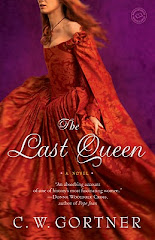I'm delighted to welcome Anne Easter Smith, whose novel ROYAL MISTRESS was published this week.
 Set in the ever-popular Plantagenet era, Anne offers us the rarely told story of Jane Shore, mistress to Edward IV, the daughter of a goldsmith who rose to fame and danger in the king's volatile court. Romance Reviews Today says the novel is a "Perfect 10": Beautifully written . . . entertaining and informative."
Set in the ever-popular Plantagenet era, Anne offers us the rarely told story of Jane Shore, mistress to Edward IV, the daughter of a goldsmith who rose to fame and danger in the king's volatile court. Romance Reviews Today says the novel is a "Perfect 10": Beautifully written . . . entertaining and informative."
Please join me in welcoming Anne Easter Smith, who brings us this fascinating guest post about Edward IV’s Women.
 Set in the ever-popular Plantagenet era, Anne offers us the rarely told story of Jane Shore, mistress to Edward IV, the daughter of a goldsmith who rose to fame and danger in the king's volatile court. Romance Reviews Today says the novel is a "Perfect 10": Beautifully written . . . entertaining and informative."
Set in the ever-popular Plantagenet era, Anne offers us the rarely told story of Jane Shore, mistress to Edward IV, the daughter of a goldsmith who rose to fame and danger in the king's volatile court. Romance Reviews Today says the novel is a "Perfect 10": Beautifully written . . . entertaining and informative."Please join me in welcoming Anne Easter Smith, who brings us this fascinating guest post about Edward IV’s Women.
I know we are all mesmerized by Richard III at the moment, but as
a king, his brother Edward IV was far more influential, being that he reigned
for more than 20 years from 1461-1483 (give or take the 10 months he was in
exile), and Richard reigned for only two (1483-1485). So, I set out to make Edward more prominent when I chose Jane
Shore as my protagonist in Royal Mistress. Of course, he had appeared in three
of my other four books, and I had formed a pretty good idea of who he was after
all those years of researching the York family during the Wars of the Roses.
It’s astonishing how much larger than life he became as I wrote about him. Had
he lived today, he would probably have been a celebrated professional athlete
or maybe a movie star--with the requisite trophy girlfriend on his arm.
He brought England out of a hundred plus years of war--first with
France and then with his cousins, the Lancaster branch of the Plantagenets.
Finally, in the 1470s and early ‘80s, England was able to concentrate on
building up its economy at home, while the merchant class was thriving. Trouble was, Edward was really better sitting on a horse and
leading his men to battle than sitting on his throne leading politicians, and I
think he got bored. By the time he was in his mid-thirties he was overweight
and indolent. However, he never lost his lust for the opposite sex. Although the names that have come down to us of his known
mistresses number a mere five, Edward and his chamberlain were reputed to enjoy
the pleasures of unsuitable young ladies on occasion during their forays into
the city of London.
Sir George Buck, in his “History of the Life and Reign of Richard
III” published in 1646 and who was the first historian to try and rectify the
bad reputation the Tudors had foisted on Richard, mentions a little known first
mistress of Edward, Catharine de Claringdon, but he is the only one who has. However, the other four women are well documented. I shall skip
over his queen, Elizabeth Woodville, as for most of Edward’s reign she was his
acknowledged wife, although he did fall hook, line and sinker for her and thus
marry her in secret to get her into bed, knowing she was really not a suitable
consort for the king of England.
 |
| Edward IV |
So who were the three mistresses of whom Edward himself remarked
that one “was the wiliest, another the merriest, and the third the holiest
harlot in the land.” We are not sure which order the first two (and let’s throw
Elizabeth Woodville in that timeline, too) came, but they were written about in
1460s, the early part of Edward’s reign.
We do know that Jane Shore was Edward’s last mistress, beginning
in the mid 1470s and still in favor when he died, and the one Edward described
as the “merriest.” Poor Eleanor Butler, nee Talbot, ended her life in a
nunnery, which might suggest why Edward nicknamed her his “holiest” concubine. By process of elimination, the “wiliest” must have been Elizabeth
Lucy, nee Wayte, often called the elusive mistress. We think she was born in
1445, three years after Edward, and was the daughter of a landowning family
from Hampshire. She became the wife of a knight named Lucy and was widowed
young. She gave birth to two of Edward’s known bastards: Elizabeth, born circa
1463, who ended up marrying a Thomas Lumley; and Arthur “Wayte” in 1465 or
1467, who was finally recognized at court, surprisingly by King Henry VII, and
rose to become Viscount Lisle. Why Elizabeth was wily, we aren’t sure, but she
was never mentioned after 1467, giving rise to the supposition she may have
died giving birth to Arthur.
The more interesting of the early mistresses is Lady Eleanor
Butler, nee Talbot, daughter of the earl of Shrewsbury. This was no commoner,
and her sister was the duchess of Norfolk, and both were known for their
beauty. She married Sir Thomas Butler, heir to Lord Sudeley, at age fourteen or
thereabouts, whose pedigree had connections to royalty. Sir Thomas died in 1461
leaving her childless and a wealthy widow. It was when she appealed the Crown’s
confiscating her inheritance that she petitioned the lusty Edward in person and
was soon being pursued by the handsome young king. But did he or did he not promise her marriage in order to get her
into his bed--commonly known as a pre-contract? That is the question that had
enormous ramifications for Edward’s son and heir at the time of his death in
1483. Let me explain.
Today, there is nothing binding between a man and a woman
promising to marry. We call it an engagement and is usually the precursor to the
actual binding of the couple in matrimony. In medieval times, the promise of
marriage followed by intercourse was tantamount to a binding commitment or
marriage and recognized by the church. After Edward’s death, his brother Richard of Gloucester became
Protector of his nephew, the boy king Edward V, who was awaiting his
coronation. During those precarious weeks in May and June 1483, the Bishop of
Bath and Wells, one Robert Stillington, stepped forward and declared he had
been witness to a pre-contract between Edward and Eleanor BEFORE Edward
secretly married Queen Elizabeth Woodville, making Edward’s marriage with the
queen was bigamous and thus bastardizing all the offspring of that union.
Ah, you say, but Richard of Gloucester had designs on the throne
and probably paid the bishop to come forward with this preposterous story. Why
did he wait until Edward was dead to announce his information to the world? Why
didn’t Eleanor Butler come forward at the time of Edward’s announcement of his
marriage to Elizabeth in 1464; surely she had a better claim to that marriage
certificate? We have to remember that this was in medieval times and women had
no power, especially a woman like Eleanor who had no father or husband or
brother to step forward for her. It would be her word against Edward’s and
Edward was the king. What about the good Stillington? He knew how to feather
his nest: Was it coincidence that at the beginning of the year of Edward and
Eleanor’s pre-contract, Stillington held only a couple of minor ecclesiastical
appointments and was keeper of the Privy Seal, but later that same year he was
given a handsome annual salary, and when the marriage of Edward and Elizabeth
was revealed, Stillington became Bishop of Bath and Wells. Hmmm, a possible
reward for keeping his mouth shut?
 |
| Anne Easter Smith |
When all hope was lost to Eleanor by the marriage of the king to
Elizabeth, she retired into a convent and died there in 1468. Poor “jilted”
Eleanor. Edward managed to ignore the whole episode until it came back to bite
him in his posterior--posthumously. Edward’s final--and he is said to have declared
favorite--mistress was Jane Shore, the subject of Royal Mistress.
Unfortunately, for Jane she was still in favor when Edward suddenly died,
leaving our heroine without a protector. She had left her husband and been
ostracized by her father, and she could have been reduced to penury and
ridicule had Edward’s chamberlain and friend Will Hastings not taken her under
his wing.
But I don’t want to spoil the drama that was Jane Shore’s rise
and fall. You’ll have to read Royal Mistress discover that for yourself! All
I will say is that she was witness to some of the most compelling events in
15th century English history, the lover of three powerful men, and the
unfortunate scapegoat of my favorite king, Richard III. Jane’s story has
inspired plays, poems, ballads and prose down the centuries, and her nickname
was always The Rose of London.
Thank you, Anne. We wish you the best of success with this new novel! To discover more about Anne and her work, please visit her website.












No comments:
Post a Comment